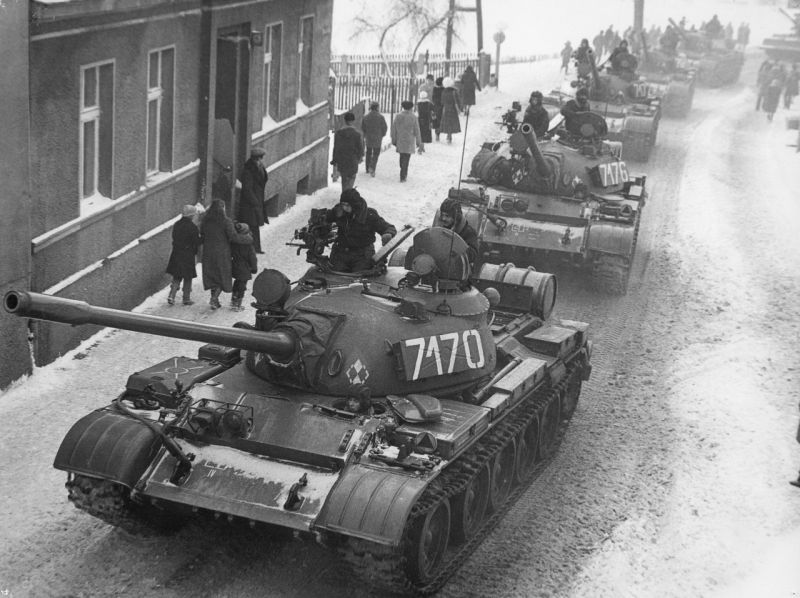On the night of 12-13 December, the communist authorities in Poland imposed martial law. During it, more than 10,000 people were interned, censorship was introduced, a curfew was established, and thousands of people were sentenced for opposition activities. A symbol of resistance against the authorities was the strike at the Wujek mine in Katowice, where policemen used firearms to pacify it, resulting in the deaths of nine miners.
The imposition of martial law in Poland on the night of 12-13 December 1981 brought a brutal end to a period in the history of the PLP known as the Solidarity carnival. It began in the summer of 1980, when, first as a result of strikes in July 1980 in the Lublin region and in August of that year on the Baltic coast, the communist authorities in Poland agreed to make significant concessions to the protesters. As a result, the Independent Self-Governing Trade Union “Solidarity” was established.
The communist authorities’ consent to independent trade union activity was purely a tactical ploy, as at the time they were unable to crush the workers’ protests by force.
By creating the impression of consenting to Solidarity’s activities, the communist decision-makers began to take steps to restore the previous status quo.
In connection with the protests in mid-August 1980, the headquarters of Operation Summer 80 was set up in the Ministry of the Interior (MSW), which continued its activities despite the end of the strikes. Officers of the communist secret police – the Security Service (SB), together with representatives of the Ministry of National Defence (MON), played an important role in the work of the Committee for the Defence of the Country, which prepared plans for the imposition of martial law.
By the end of March 1981, work was completed on the basic planning documents in this regard (‘Guiding principle in the conduct of martial law on the territory of the People’s Republic of Poland due to the security of the state’ ‘Central plan of actions of political authorities and state administration in the event of the necessity of introducing martial law in the People’s Republic of Poland’ ‘Framework plan of actions of the armed forces in the event of the introduction of martial law’). At the same time, Soviet KGB and military officers were in Poland. Their task was not only to support Polish comrades but also to supervise that preparations for the introduction of martial law were completed.
At this time, the office of Poland’s Prime Minister was taken by General Wojciech Jaruzelski, who, in his parliamentary expose, proposed that Solidarity put an end to the disputes and called for ninety peaceful days. At the same time, work on the preparations for the imposition of martial law was not only continued but even intensified during this period. In July 1981, Jaruzelski’s trusted man General Czesław Kiszczak, until recently head of the military security service, became Minister of the Internal Affairs. By the beginning of September 1981, most of the legislation introducing martial law had already been prepared.
In order to keep the preparations strictly secret, a decision was made to print 25,000 posters informing about the introduction of martial law in the KGB’s printing plant in Moscow. In mid-October 1981, the Soviets came to the conclusion that General Jaruzelski guaranteed the establishment of “order” in Poland, so they agreed to let him become the First Secretary of the Polish United Workers’ Party (PZPR). Preparations for the imposition of martial law thus entered a decisive phase.
The final decision to impose martial law on the territory of the People’s Republic of Poland was taken just after midday on 12 December 1981. Orders were sent to the provincial police commands and the commands of individual military units, ordering the implementation of the plans sent earlier. On the night of 12-13 December 1981, the internment of Solidarity activists (a total of around 10,000 people during martial law) began under the “Jodła” campaign.
In a tv speech, General Jaruzelski announced the imposition of martial law by the Council of State of the People’s Republic of Poland (PRL). This was a breach of the law at the time, because according to the provisions of the Constitution of the People’s Republic of Poland, the Council of State could only issue decrees outside sessions of the Sejm, and this was not the case here.
Restrictions were imposed on society: including a ban on strikes and assemblies, the suspension of trade unions, the militarisation of a number of areas of the national economy, and the introduction of curfews. The first strikes already broke out on Sunday 13 December 1981, but the real wave of strikes did not begin to spread until the following day. On 14 December, several hundred factories across the country were already on strike. The communist authorities decided to break the resistance by force, and General Czesław Kiszczak even allowed the use of firearms. The most tragic events took place in Katowice, where six miners were killed and three more died of their wounds during the pacification of the strike by the army and police officers at the Wujek mine.
General Jaruzelski, especially after 1989, repeatedly indicated that, with the threat of Soviet intervention, martial law was to be the ‘lesser evil’. It is clear from the documents available today, including Soviet documents, that the Soviet Union did not plan such an intervention in Poland in the winter of 1981. On the other hand, it is known that on 11 December, in a conversation with Marshal Viktor Kulikov, Commander-in-Chief of the Warsaw Pact forces, General Jaruzelski asked for “military assistance”, which was refused.
Martial law was suspended on 31 December 1982 and lifted on 22 July 1983.





